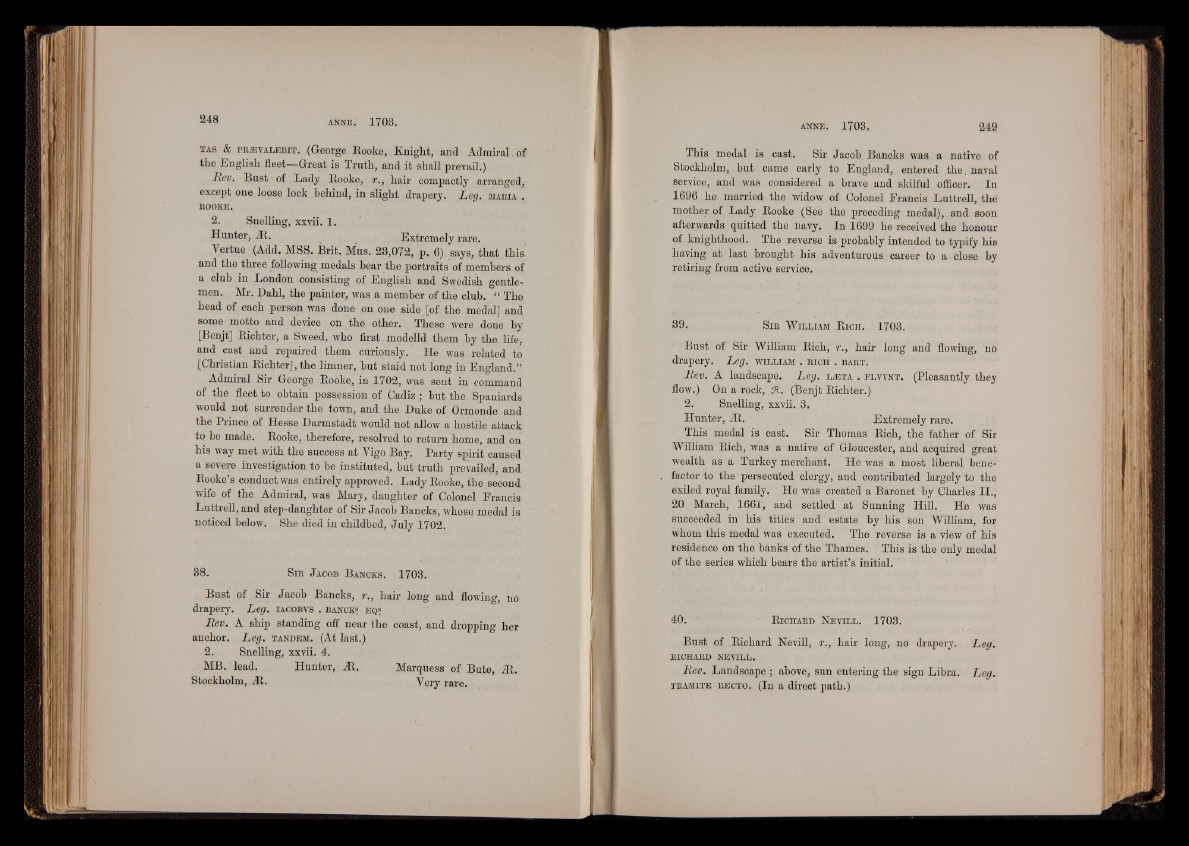
ta s & PRiEVALEBiT. (George Rooke, Knight, and Admiral,of
the English fleet—Great is Truth, and it shall prevail.)
Rev. Bust of Lady Kooke, r., hair compactly arranged,
except one loose lock behind, in slight drapery. Leg. makia .
KOOKE.
2. Snelling, xxvii. 1 .
Hunter, At. Extremely rare.
Vertue (Add. MSS. Brit. Mus. 23,072, p. 6) says, that this'
and the three following medals bear the portraits of members of
a, club in London consisting of English and Swedish gentlemen.
Mr. Dahl, the painter, was a member of the club. “ The
head of each person was done on one side [of the medal] and
some motto and device on the other. These were done by
[Benjt] Kichter, a Sweed, who first modelld them by the life,
and cast and repaired them curiously. He was related to
[Christian Richter], the limner, but staid not long in England.”
Admiral Sir George Kooke, in 1702, was sent in command
of the fleet to obtain possession of Cadiz; but the Spaniards
would not surrender the town, and the Duke of Ormonde and
the Prince of Hesse Darmstadt would not allow a hostile attack
to be made. Kooke, therefore, resolved to return home, and on
his way met with the success at Vigo Bay. Party spirit caused
a severe investigation to be instituted, but truth prevailed, and
Rooke’s conduct was entirely approved. Lady Kooke, the second
wife of the Admiral, was Mary, daughter of Colonel Francis
Luttrell, and step-daughter of Sir Jacob Bancks, whose medal is
noticed below. She died in childbed, July 1702.
38. Sik J acob B a n c k s . 1703.
Bust of Sir Jacob Bancks, r., hair long and flowing, no
drapery. Leg. iacobvs . bancks e q ?
Rev. A ship standing off near the coast, and dropping her
anchor. Leg. t a n d em . (At last.)
2. Snelling, xxvii. 4.
MB. lead. Hunter, At, Marquess of Bute, At.
Stockholm, At. Very rare.
This medal is cast. Sir Jacob Bancks was a native of
Stockholm, but came early to England, entered the, naval
service, and was considered a brave and skilful officer. In
1696 he married the widow of Colonel Francis Luttrell, the
mother of Lady Kooke (See the preceding medal), , and soon
afterwards quitted the navy. In 1699 he received the honour
of knighthood. The reverse is probably intended to typify his
having at last brought his adventurous career to a close by
retiring from active service.
39. S ib W il l ia m R ic h . 1703.
Bust of Sir William Rich, r., hair long and flowing, no
drapery. Leg. william . rich . bakt. *
Rev. A landscape. Leg. l^jta . f lw n t . (Pleasantly they
flow.) On a rock, (Benjt Richter.)
2. Snelling, xxvii. 3.
Hunter, At. Extremely rare.
This medal is cast. Sir Thomas Rich, the father of Sir
William Rich, was a native of Gloucester, and acquired great
wealth as a Turkey merchant. He was a most liberal benefactor
to the • persecuted clergy, and contributed largely to the
exiled royal family. He was created a Baronet by Charles II.,
20 March, 1661, and settled at Sunning Hill. He was
succeeded in his titles and estate by his son William, for
whom this medal was executed. The reverse is a view of his
residence on the banks of the Thames. This is the only medal
of the series which bears the artist’s initial.
40. ■ R ic h a r d N e v i l l . 1703.
Bust of Richard Nevill, r., hair long, ne drapery. Leg.
RICHARD NEVILL.
Ren. Landscape; above, sun entering the sign Libra. Leg.
t r a m it e r e c t o . (In a direct path.)